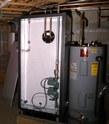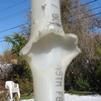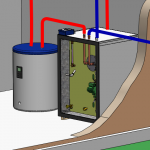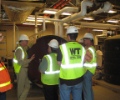December’s Solar Thermal Webinar

Happy Holidays to our readers! If you were unable to tune in to our most recent webinar, we’ve posted a recording here. What did we cover? A lot! But primarily we discussed a tool called the Engineering Data Form. This a spreadsheet that we use to help properly size the major components of a solar thermal fluid handling system…
Solar Water Heating in Waukesha!

The mechanical room at the STEM Academy Saratoga Campus is proof that there are learning opportunities everywhere. A location in the building that most people walked by without a second thought was harboring some pretty interesting scientific processes the whole time, said teachers at the school. Renovations to the room have transformed it into a thermal energy laboratory with three systems on display; a water tank heated by solar energy, a gas-powered hot water heater, and a steam-powered heating system.
Different Kinds of Drainback Solar Water Heating Systems

Most people don’t know that there are several different kinds of drainback solar water heating systems. They look very much like glycol systems with the important difference that they contain no glycol, expansion tanks, check valves, or any other components required for dealing with pressurization. The water drains out of the collectors when the pump stops…
November’s Solar Thermal Webinar

In the recent November edition of our Question & Answer webinar we reviewed some more of the fundamental principals that support successful solar thermal design. Specifically, we continued our ongoing comparison of the pluses and minuses of both pressurized and non-pressurized solar water heating systems.
Solar Thermal Presentation to the Society of American Military Engineers

I had the opportunity to give another solar thermal seminar recently. This time I presented to the Society of American Military Engineers in Panama City, FL on October 14th. A video of the presentation is available below. If you’d like to follow along using PowerPoint, the slides are available here.
Just Say No to Glycol

“My question is how to determine the correct pressure for the pre-charged expansion tank, owing to the fact that the system will not be subjected to the mains cold water pressure which will be approx 80 PSI.” – Paul
Is PEX OK for a Drainback Solar Water Heater?

I generally don’t recommend using PEX in the collector loop, especially in the return line coming back from the collectors into the tank. PEX tubing, will deform under steam and eventually fail over time. We don’t have to worry about this with copper.
Variable Speed Pumps (cont.)
I am still examining the benefits of a variable speed collector pump and your data lends credence to the idea. However, our system has some characteristics that make the use of variable speed pumps more difficult. We put all water cooled collector pumps inside our thermal cavity, where the heat from the pump goes into the tank water. We cannot put a variable speed pump there because…
One tank or two, sir?

The efficiency of a solar thermal system increases as the temperature of the water flowing through the collectors decreases. This is just basic physics. We don’t want the solar water to be any warmer than necessary at any given time. Systems that are designed and operated with this principle in mind will generate energy more efficiently…
Variable Speed Pumps

“Dr. Ben, on the hospital that you were pumping up 5 floors to the 50 collectors; you did talk about the pump and control with out detail. Are you using a variable speed pump control to prevent short cycling and excess velocity?” – Rod